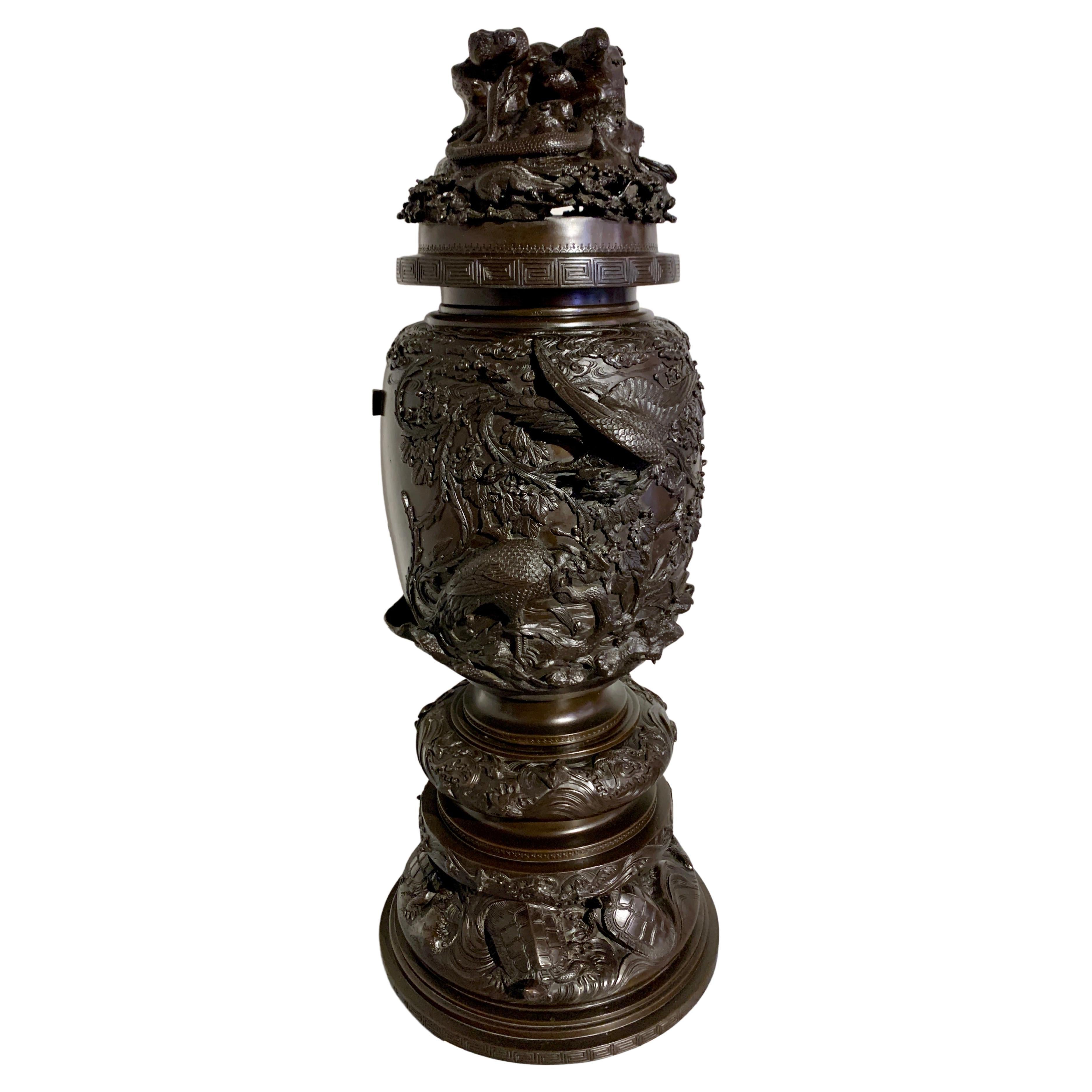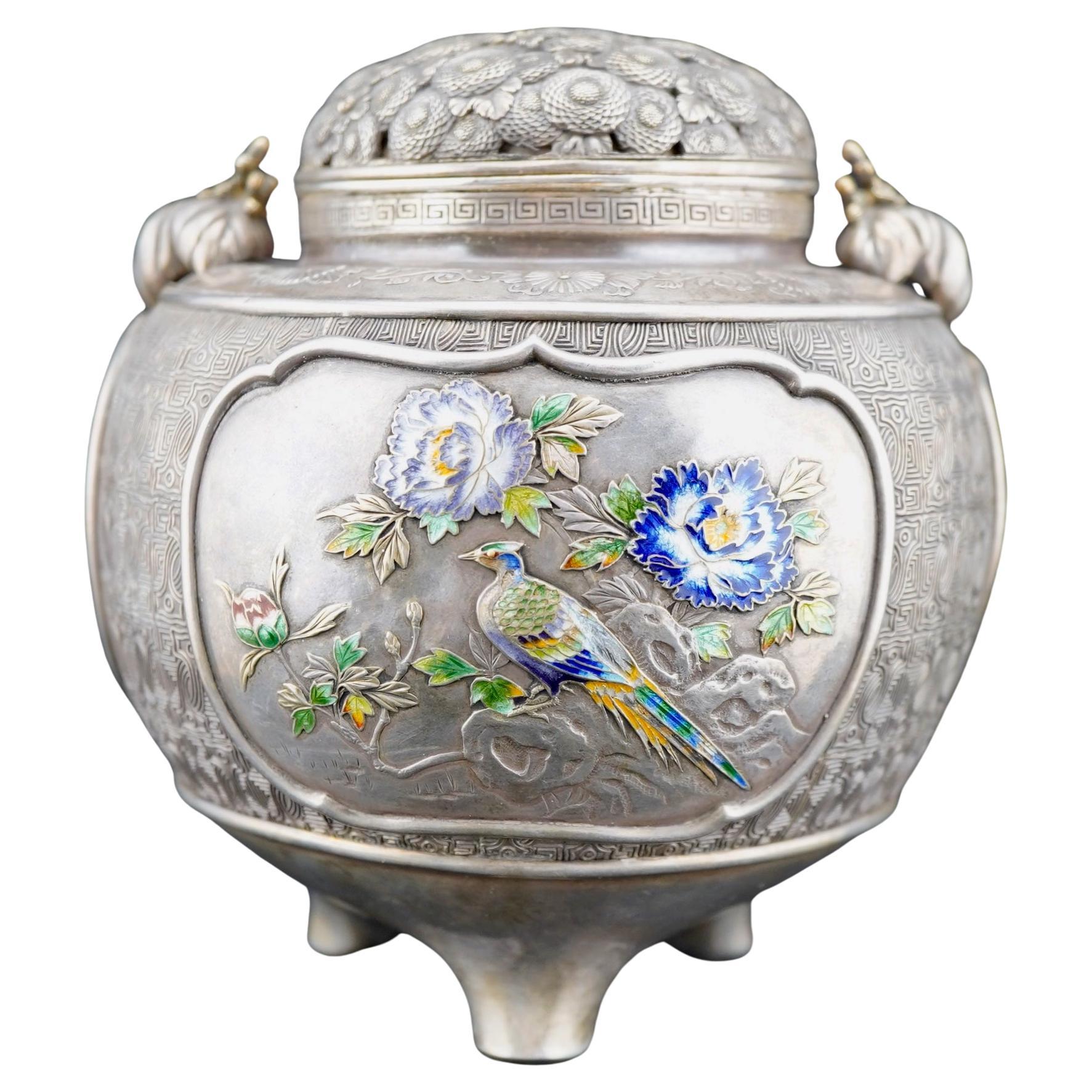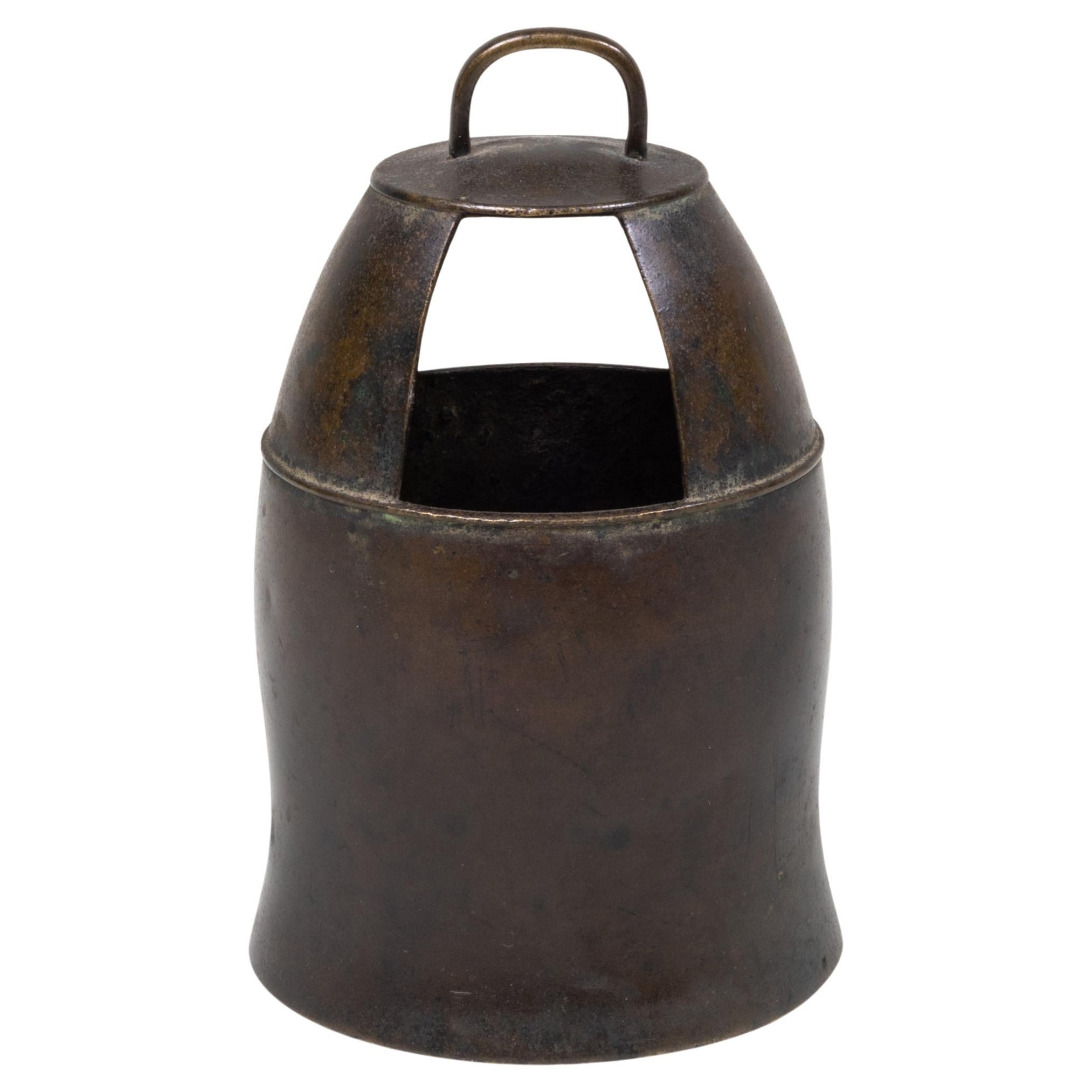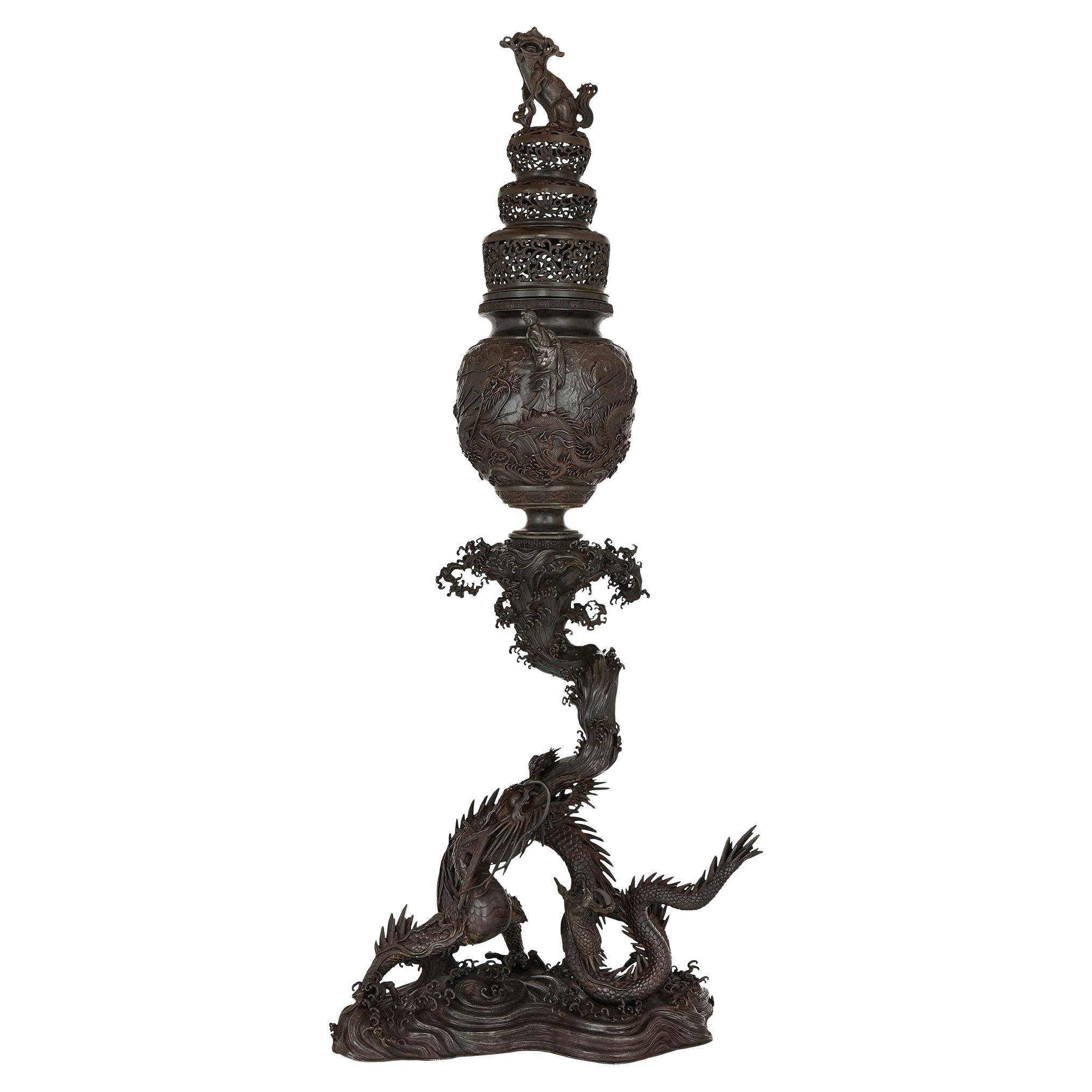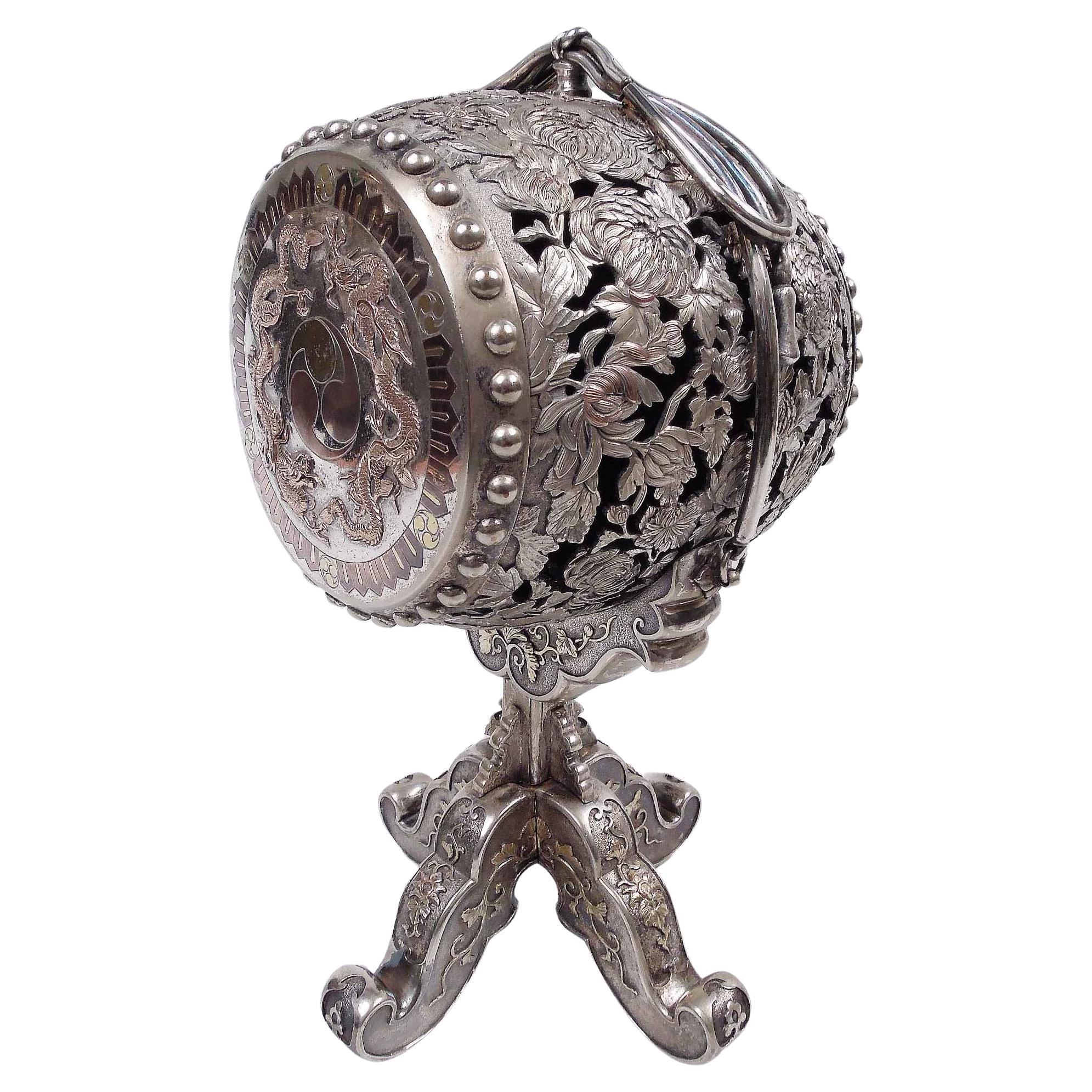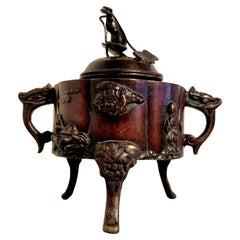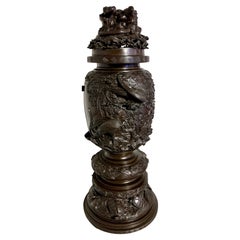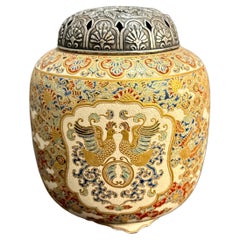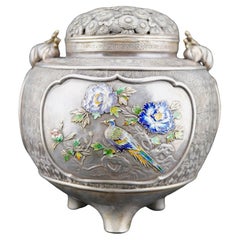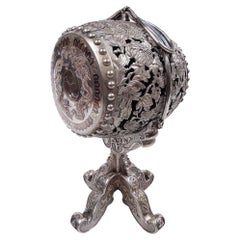Items Similar to Japanese Silver Incense Burner, Akoda Koro, by Nomura, Meiji Period, Japan
Want more images or videos?
Request additional images or videos from the seller
1 of 14
Japanese Silver Incense Burner, Akoda Koro, by Nomura, Meiji Period, Japan
About the Item
A lovely and luxurious Japanese silver incense burner of lobed melon form, akoda koro, marked jungin and signed Nomura, Meiji Period, circa 1900, Japan.
The silver koro, vessel for burning incense, takes on a traditional six lobed melon shape, a form known as akoda koro. The sides are decorated in the repousse technique with large and bold stalks of blooming chrysanthemum flowers and leaves in relief. The pierced openwork cover also of repousse and with further floral sprays.
The underside of the vessel marked with a five character inscription reading "Nomura tsukuru" (made by Nomura), and jungin (pure silver).
Nomura of Nagahama was a silversmith or retail shop active during the late Meiji and Taisho periods. They were known for producing high quality works in silver.
The jungin mark indicates a silver purity of at least 95%, a higher purity standard than sterling silver.
193.3 grams / 6.21 troy ounces.
- Dimensions:Height: 3.25 in (8.26 cm)Diameter: 3.5 in (8.89 cm)
- Style:Meiji (Of the Period)
- Materials and Techniques:
- Place of Origin:
- Period:1910-1919
- Date of Manufacture:circa 1910
- Condition:Wear consistent with age and use. In fine condition. With some tarnish to the recessed and interior, and minor scratches and small dents to the underside, as seen in photos.
- Seller Location:Austin, TX
- Reference Number:1stDibs: LU894733908482
About the Seller
5.0
Vetted Professional Seller
Every seller passes strict standards for authenticity and reliability
Established in 2001
1stDibs seller since 2010
338 sales on 1stDibs
Typical response time: 1 hour
- ShippingRetrieving quote...Shipping from: Austin, TX
- Return Policy
Authenticity Guarantee
In the unlikely event there’s an issue with an item’s authenticity, contact us within 1 year for a full refund. DetailsMoney-Back Guarantee
If your item is not as described, is damaged in transit, or does not arrive, contact us within 7 days for a full refund. Details24-Hour Cancellation
You have a 24-hour grace period in which to reconsider your purchase, with no questions asked.Vetted Professional Sellers
Our world-class sellers must adhere to strict standards for service and quality, maintaining the integrity of our listings.Price-Match Guarantee
If you find that a seller listed the same item for a lower price elsewhere, we’ll match it.Trusted Global Delivery
Our best-in-class carrier network provides specialized shipping options worldwide, including custom delivery.More From This Seller
View AllJapanese Bronze Incense Burner, Koro, Meiji Period, circa 1900, Japan
Located in Austin, TX
A darling and charming small Japanese cast bronze incense burner, koro, Meiji Period, circa 1900, Japan.
The small incense burner, koro, set on three tall and splayed legs with pawe...
Category
Antique Early 1900s Japanese Meiji Scholar's Objects
Materials
Bronze
Large Japanese Bronze Koro Incense Burner, Meiji Period, 19th Century, Japan
Located in Austin, TX
A large and fantastic Japanese cast bronze incense burner, koro, with high relief design, Meiji period, late 19th century, Japan.
The large and tall koro cast in extremely high re...
Category
Antique Late 19th Century Japanese Meiji Metalwork
Materials
Bronze
Japanese Satsuma Incense Burner, Koro, with Silver Lid, Meiji Period, Japan
Located in Austin, TX
A fantastic Japanese Satsuma incense burner, koro, with phoenix and brocade designs and a silver lid, Meiji Period, late 19th century, Japan.
The cens...
Category
Antique 1890s Japanese Meiji Ceramics
Materials
Silver
Japanese Parcel Gilt Copper Hibachi, Edo Period, 18th Century, Japan
Located in Austin, TX
A sublime Japanese parcel gilt copper hand warmer, hibachi, with chrysanthemum design, Edo Period, 18th century, Japan.
The hand warmer, called a...
Category
Antique 18th Century Japanese Edo Metalwork
Materials
Copper
Japanese Satsuma Incense Burner, Koro, Meiji Period, Late 19th Century, Japan
Located in Austin, TX
A fine and elegant Japanese Satsuma tripod incense burner, koro, with pierced metal lid, signed Eizan (?) Meiji Period, late 19th century, Japan.
The koro, or censer, features a stoneware body of slightly compressed globular form, supported on three short and squat legs. The wide mouth with a recessed metal rim, and topped by an openwork metal lid topped with overlapping chrysanthemum blossoms of silver repousse.
The body of the koro finely painted with fan shaped cartouches. The fans in the foreground with sprays of blossoming chrysanthemum. The fans in the background with intricate geometric brocade designs.
The shoulder of the incense burner decorated with cartouches formed as stylized chrysanthemum petals, and intricately decorated with geometric and floral brocade designs.
The painting finely done in raised gilt and polychrome enamels, including the highly desirable gosu blue...
Category
Antique Late 19th Century Japanese Meiji Ceramics
Materials
Silver, Metal
Chinese Cloisonne Incense Tool Vase, Qing Dynasty, 18th/19th Century, China
Located in Austin, TX
A small and elegant Chinese cloisonné vase for incense tools, Qing Dynasty, 18th/19th century, China.
Made for the scholar's studio, this small refined vase, was used to hold incense tools, including a small pair of tongs or chopsticks and spoon. The tools no longer present.
Of miniature baluster vase form, the vase beautify proportioned and decorated in the cloisonné enamel technique, with gilt wires forming the cloisons, or partitions. Within the cloisons, colorful enamels have been expertly laid.
The small incense tool vase...
Category
Antique Early 1800s Chinese Qing Scholar's Objects
Materials
Copper, Enamel
You May Also Like
Japanese Silver Enamel Incese Burner (Koro) Meiji Period
By Sanju Saku
Located in Sarasota, FL
Japanese silver and enamel Incense Burner (Koro) Meiji era (1868-1912), late 19th century. The koro is set on tripod feet, The body decorated with three panels of birds and flowers w...
Category
Antique 1890s Japanese Metalwork
Materials
Silver
Japanese Bronze Incense Burner 'Koro'
Located in Hudson, NY
Wood storage box.
Category
Antique 18th Century Japanese Metalwork
Materials
Bronze
Large Patinated Bronze Japanese Koro Incense Burner
Located in London, GB
Large patinated bronze Japanese koro incense burner
Japanese, late 19th Century
Dimensions: Height 221cm, width 97cm, depth 57cm
This monumental koro...
Category
Antique Late 19th Century Japanese Meiji Metalwork
Materials
Bronze
Fine Quality Japanese Meiji Chrysanthemum Silver Incense Burner
Located in New York, NY
Fine quality Japanese Meiji silver incense burner, ca 1890. Barrel-form with solid top and bottom and open sides; applied chrysanthemums heightened with gold and silver. Cover oval a...
Category
Antique Late 19th Century Japanese Meiji Metalwork
Materials
Silver
Japanese Meiji Period Mixed Metal Pair of Scroll Weights Depicting Samurai
Located in Sarasota, FL
Japanese Meiji period fine pair of scroll weights decorated with shakudo and silver samurai figures. The weights fill solid and heavy. One of the weights has Japanese writing ( see i...
Category
Antique 19th Century Japanese Meiji Metalwork
Materials
Metal
Japanese Glazed Ceramic and Silver Koro Incense Burner Makuzu Kozan
By Makuzu Kozan
Located in Atlanta, GA
A tri-pod ceramic incense burner (koro) by Japanese Imperial potter Makuzu Kozan (1842-1916) circa late Meiji to the start of Taisho period (1890-1910s). A fine example of the artist's work belonging to the late part of his underglaze paint phase (started around 1887 until his death), the surface of the koro was painted in beautiful shades of blue to depict a continuous landscape not unlike a traditional ink and watercolor hand scroll. The rise and fall mountains recede and fade into the horizon and are dotted with groves of pines. The sky is painted with a beautiful subtle shade of pink, suggesting a time of sunrise or sunset. The koro is fitted with an ensuite reticulated sterling silver hoya (incense cover), pierced with swirling cloud and marked with "pure silver' in Kanji. The base is signed in underglaze blue "Makuzu Kozan Sei" within a double ring. The piece is beautifully potted in form and the decoration was done with expertise using the novel technique developed by Kozan called Fuki-e (the blow painting), in order to achieve the striking landscape known as "Mountain and Water" with sense of dimensions and gradient, the poetic effects normally conveyed only by sumi ink staining on paper. The piece comes with an unsigned tomobako (wood storage box) of a recent age.
Also known as Miyagawa Kozan (1842–1916), Makuzu Kozan was one of the most established and collected ceramist from Meiji Period. Born as Miyagawa Toranosuke, Kozan established his pottery studio in Yokohama around 1870s and later became one of the appointed artists to the Japanese Imperial household. His work was exhibited in many international fairs that the Meiji government participated at the turn of the century and won many grand prizes. Being one of the most creative ceramists, Kozan started experimenting with new chemical colors from the West in the format of his porcelain glaze around 1880s. New colors allowed him to create underglaze designs that appeared bright, smooth and glossy. He even invented his own receipt of cobalt blue to achieve a much brighter yet softer shade, as evident on this vase. To create landscape that is realistic and dimensional, more common in the western paintings, he was inspired by the native Japanese ink painting technique developed around 1900 by Yokoyama...
Category
Antique Early 1900s Japanese Japonisme Ceramics
Materials
Silver
Recently Viewed
View AllMore Ways To Browse
Japanese Antique Silver
Japanese Antique Marks
Sterling Silver Japan
Japanese Shop Sign
Chrysanthemum Sterling Silver
Sterling Silver Burner
Incense Burner Silver
Japanese Koro Silver
Bronze Kettle
China Brazier
Copper Persian Tray
Qajar Engraved
Turkish Copper Pot
Antique Dallah
Antique Iron Stirrups
Arabic Dallah
Cast Iron Kettle
Chinese Censer Dragon

